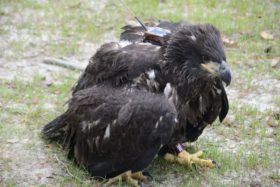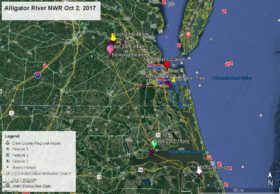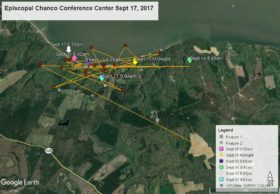Busy Morning at NBG Eagle Nest Jan 16
Azalea at Alligator River NWR Jan 15
January 16, 2010Camera down at NBG
January 17, 2010





In contrast to the morning of Jan 15 when both adult eagles came to the nest early in the morning, stayed about 30 minutes and then left until late in the afternoon, this morning Jan 16 has been very busy at the NBG nest. Both adults arrived about 6:40am and at 6:52 mated (copulated) on the front branch – also known as the “love branch”. They both then made several flights to bring in sticks and pine straw which they tucked into the nest. About 9:10 the male left. At 9:40 he returned with a gull that he likely caught at Lake Whitehurst – the first brought to the nest this season – which he began plucking. At 9:43 the female who was on the front branch flew to the nest. The male left. For the next 45 minutes she fed on the gull. At 10:27 the male returned and ate the few remaining scraps that the female had not devoured. They both then did a bit more nest arranging, after which they returned to the “love branch” and copulated again. The male left and the female hung around until about noon, then she too left. Busy morning!!
Note that the pile of feathers in the nest will help provide cushion and insulation in the pocket of the nest for the eggs we all expect within the next couple weeks.




4 Comments
Interesting use of the feathers from another bird. I know they use their own down to soften/line the nest but not gull feathers. Learn something new each day. Thanks Reese for the information you keep providing us.
Thanks Reese
I am excited to have our mom and dad back on cam. They are exceptional !!! I am wishing for them wonderful and healthy babies.
Answer when/if you have time :
Have been watching Channel Islands Eagles #10 and #26 with the “wing tags” (don’t know what they are called) – any plans to go to this form of ID or staying with our purple bands or both ? LOL
Kim
Dixiemom – CCB will continue to use the Purple leg bands which are issued by the U.S. Geological Survey (USGS) to identify eagles banded in the Chesapeake Bay region. The wing markers you refer to are also called patagial markers and are used on special projects. Virginia DGIF has used them on Black Vultures where their population is so large they have become pests, and biologists want to know where they are all coming from.
Thanks Reese. Just wondering. I do love their purple bands – is Az’s favorite color. I fully understand what you are saying about the Chesapeake Region.
Thanks for the answer.
Kim